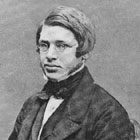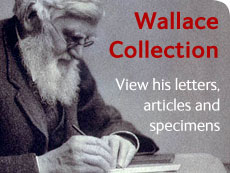Alfred Russel Wallace
An intrepid explorer and brilliant naturalist, Alfred Russel Wallace co-published the theory of evolution by natural selection with Charles Darwin. So why isn't he as well known?

Alfred Russel Wallace (1823-1913).
Alfred Russel Wallace was a man of many talents - an explorer, collector, naturalist, geographer, anthropologist and political commentator. Most famously, he had the revolutionary idea of evolution by natural selection entirely independently of Charles Darwin.
This ground-breaking theory changed the way we understand the natural world, and ourselves. But Wallace's remarkable accomplishments are not as appreciated today as they were in his own lifetime.
Video
In this video Museum curator George Beccaloni tells us about two of Wallace’s intrepid collecting expeditions and how he went on to discover the theory of evolution by natural selection.
Wallace was one of the most prolific collectors of natural history specimens of all time. His collecting trips often lasted for years, but did not always have a happy ending, as George explains.
For a more detailed look at his work and life read Wallace’s biography on the Work and Timeline sections. Discover who sparked his interest in the natural world and more about his huge contribution to science.
You need Adobe Flash Player, or an HTML5 enabled web browser, and JavaScript enabled to watch this video.
Visit the Adobe website to download the latest Adobe Flash Player
Work
A life-changing friendship
Wallace was born in Usk, now in Monmouthshire, in 1823. After leaving school he worked at his brother's surveying firm until he was hired as a teacher in Leicester in 1844. That year he formed a friendship with a local man and keen naturalist, Henry Walter Bates, which was to bring unexpected opportunities.
Bates introduced an enthusiastic Wallace to the methods and delights of collecting beetles. Four years later, the two men decided to leave England's green shores and head to South America. They were drawn to this fascinating continent by two books: Charles Darwin's report of his voyage on the Beagle, and the explorer Alexander von Humboldt's account of his journeys there.
Adventures on the Amazon
Wallace and Bates arrived in Brazil, at the mouth of the Amazon, in 1848. Their aim, inspired by their enthusiasm for studying nature, was to investigate the origin of species. They planned to finance the trip by collecting specimens and selling them. In order to cover more ground, the two men split up. Wallace went north by river, collecting in areas previously unexplored by European naturalists. He amassed thousands of unique and exciting animal specimens, mostly birds, beetles and butterflies.
After more than four years collecting, Wallace booked passage and sailed back to England, but disaster struck on the high seas. The ship caught fire and sank along with virtually all his specimens and diaries. Fortunately the crew and passengers were rescued by a passing ship in the mid-Atlantic.
Undaunted, Wallace started planning his next collecting expedition almost immediately. Within a year he left England again and set sail for the Far East.
The Malay Archipelago and Wallace's Line
Wallace began his travels through the Malay Archipelago (now Malaysia and Indonesia) in 1854. Over a period of eight years, he accumulated an astonishing total of 125,660 specimens, including more than 5,000 species new to science.
Wallace noticed a striking pattern in the distribution of animals around the archipelago. He proposed an imaginary line dividing the region in two major parts. Later known as Wallace's line, this marked the boundary between the animal life of the Australian region and that of Asia.
On returning home, Wallace published a travel book, The Malay Archipelago. His vivid account of the beautiful, undisturbed islands opened up a whole new world to readers. Highlights include his colourful descriptions of birds of paradise and orang-utans, and encounters with native peoples.
'In this archipelago there are two distinct faunas… yet there is nothing on the map or on the face of the islands to mark their limits' (From a letter in which Wallace describes the line that would eventually be named after him)
Wallace and Darwin
One day in 1858, while feverish and confined to his hut on the island of Ternate (now in Indonesia), Wallace had a flash of inspiration. He realised how species evolved - they changed because the fittest individuals survived and reproduced, passing their advantageous characteristics on to their offspring. Wallace immediately wrote to someone he knew was interested in the subject, Charles Darwin.
Darwin had been working on the very same theory for twenty years, but was yet to publish. He sought the advice of his friends, who determined that the ideas of both men would be presented at a meeting of the Linnean Society. Darwin's masterpiece, The Origin of Species, came out the following year.
From that time on, Darwin overshadowed Wallace and it has usually been his name alone associated with the theory of evolution by natural selection. But Wallace expressed no resentment at this, and in fact he was Darwin's greatest fan. His role in the matter, and Darwin's support, ensured his entry to the highest ranks of the scientific establishment.
'He could not have made a better short abstract! Even his terms now stand as heads of my chapters!' (Charles Darwin)
The surprising spiritualist
Wallace and Darwin did not agree on everything. Wallace, to the discomfort of many contemporaries, was a spiritualist. He believed that natural selection could not explain the human intellect, and that the human spirit persisted after death. A tireless thinker, he wrote widely on this and other diverse topics including land ownership, workers' rights, law, economics and museums. By the time of his death, Wallace had written more than 20 books and over 1,000 articles and published letters. Wallace, unlike Darwin, is not a household name but increasingly his outstanding achievements are receiving the acclaim they deserve.
Timeline
Explore the major events in Wallace's life below or browse our interactive timeline.
| 1823 | Born 8 January, Usk, England (now in Wales). |
|---|---|
| 1830 | Charles Lyell publishes The Principles of Geology proposing a vast timescale for Earth's history |
| 1837 | Victoria becomes Queen. |
| 1840–43 | Wallace works as a surveyor in west England and Wales. |
| 1844 | Hired as a master at the Collegiate School in Leicester. Meets Henry Walter Bates. |
| 1846–48 | Inherits his brother's surveying business and works for the railways in Wales, earning enough money to propose a South American expedition to Bates. |
| 1848 | Travels to the Amazon with Bates to begin a natural history collecting expedition. |
| 1851 | Ascends further up the Rio Negro – one of the Amazon's major tributaries – than any previous European. Constructs an accurate map of the course of the river. |
| 1852 | Leaves South America to return to England. His ship burns at sea and sinks. |
| 1854–62 | Travels in the Malay Archipelago, collecting specimens and formulating theories on the origin of species. |
| 1858 | Writes ‘ On the Tendency of Varieties to Depart Indefinitely From the Original Type' and sends it to Charles Darwin for comment. Later that year Wallace's and Darwin's writings on evolution by natural selection are presented at a meeting of the Linnean Society. |
| 1859 | Darwin's The Origin of Species is published. |
| 1869 | The Malay Archipelago is published. |
| 1893 | Elected Fellow of the Royal Society. |
| 1913 | Dies 7 November, Broadstone, Dorset, England. |
| 1914 | Start of the First World War. |
| 1915 | Medallion bearing Wallace's name placed in Westminster Abbey. |
| 2000 | Wallace's grave refurbished and lease extended by A. R. Wallace Memorial Fund, and held by the Linnean Society . |
